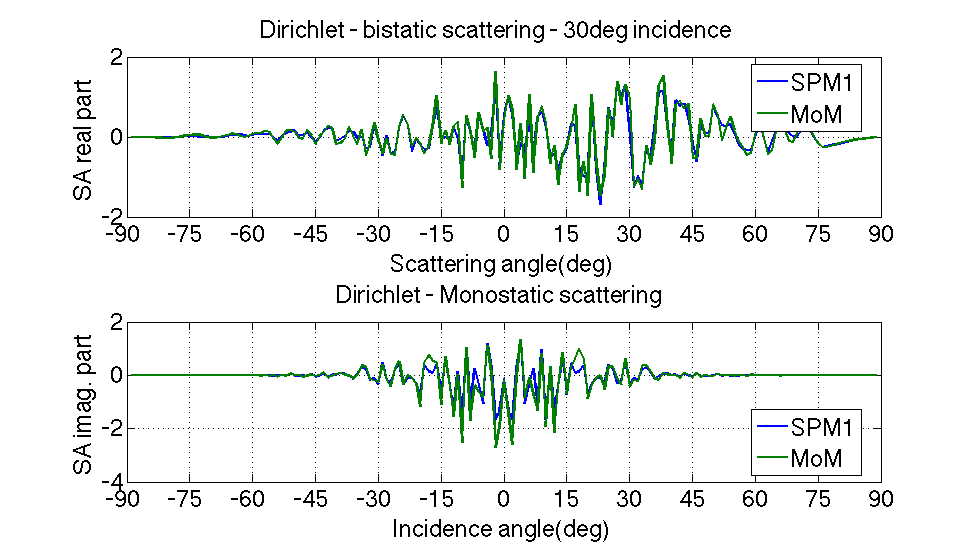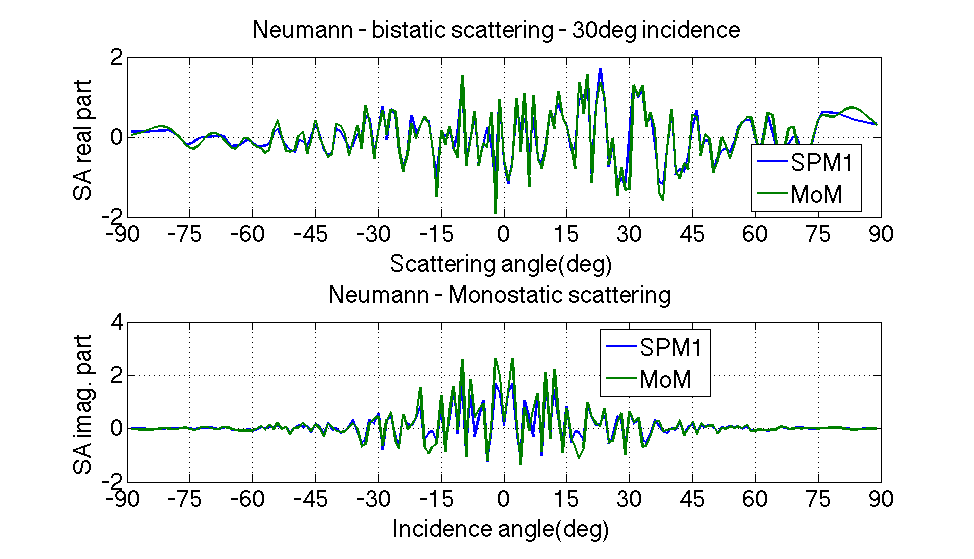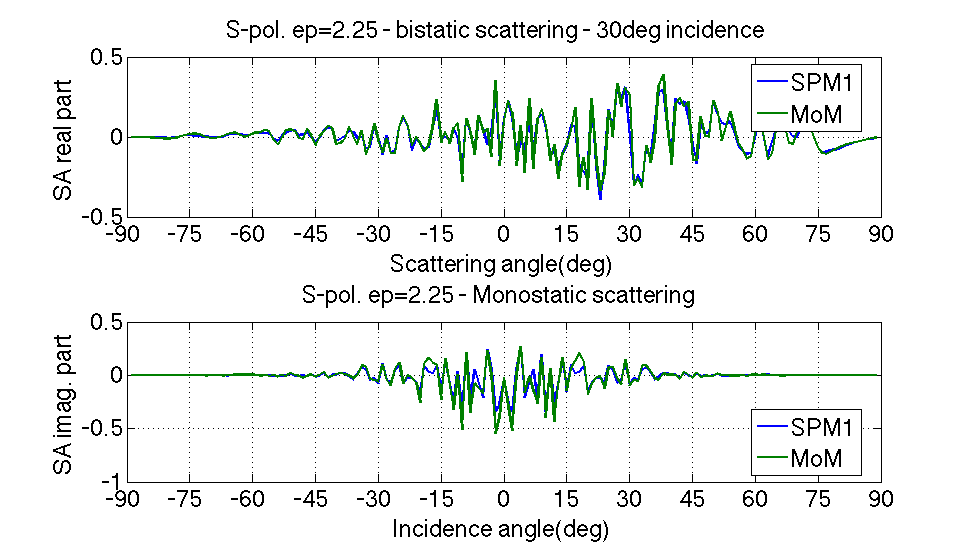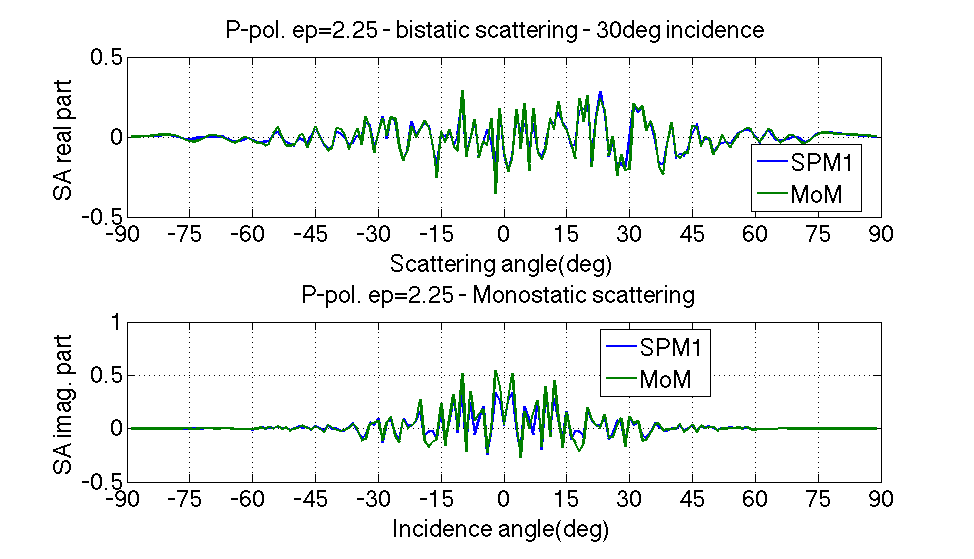The 1st-order SPM for 2D scattering a from deterministic rough surface
Contents
The scattering amplitude
For an incident plane wave impinging from air a  -invariant surface
-invariant surface  with an angle
with an angle  from the
from the  -axis, the field in the air above the surface region (that is
-axis, the field in the air above the surface region (that is  writes as the plane wave sum :
writes as the plane wave sum :  for an implicit
for an implicit  time dependency. With wavenumber
time dependency. With wavenumber  ,
,  and
and  define the incident wavevector. For the scattering one,
define the incident wavevector. For the scattering one,  is chosen so that
is chosen so that  with
with  .
.
lambda=1; % the EM wavelength is chosen as length unit rL=64*lambda; % length of the surface N=20*rL; % number of sampling points kx=[-N/2:N/2-1]'*2*pi/rL; % spatial frequencies tid=[-89:89]; % incidence angles tsd=[-89:89]; % scattering angles K0=2*pi/lambda; % EM wavenumber qf=@(k,ep) sqrt(K0^2*ep-k.^2); % ep=1 in air
The perturbative expansion
Assuming  and following the small perturbation method (SPM), the scattering amplitude
and following the small perturbation method (SPM), the scattering amplitude  is expanded into a series :
is expanded into a series :  where
where  is the Fourier transform of the height function
is the Fourier transform of the height function 
 and the coefficients
and the coefficients  are roughness-independent.
are roughness-independent.
tfdir=@(z) fftshift(fft(fftshift(z)))*(rL/N)/(2*pi); % Fourier transform of the surface profile spm=@(B1,z,k,k0) B1(k,k0).*interp1(kx,tfdir(z),k-k0); % 1st-order SPM scattering amplitude
Load the rough surface profile
load('spm1Ddet.mat','x','z')
The Dirichlet boundary condition
Enforcing  on the surface leads to :
on the surface leads to :


 with
with 
BD0=@(k0) -qf(k0,1); BD1=@(k,k0) 2*1i*qf(k,1).*qf(k0,1); BD2=@(k,x,k0) 2*qf(k,1).*qf(x,1).*qf(k0,1); load('spm1Ddet.mat','momD') % the Method of Moments provides a numerical solution of the rigorous problem figure(1) subplot(211) ii=find(tid==30); H1=plot(tsd,real(spm(BD1,z,K0*sind(tsd),K0*sind(tid(ii)))),tsd,real(momD(:,ii))); set(gca,'FontSize',24,'XLim',[-90 90],'XTick',[-90:15:90]) set(H1,'LineWidth',2) grid on,xlabel('Scattering angle(deg)') ylabel('SA real part') legend('SPM1','MoM','Location','Best'),title(sprintf('Dirichlet - bistatic scattering - %ideg incidence',tid(ii))) subplot(212) H1=plot(tid,imag(spm(BD1,z,K0*sind(tsd),K0*sind(-tid))),tid,imag(diag(fliplr(momD)))); set(gca,'FontSize',24,'XLim',[-90 90],'XTick',[-90:15:90]) set(H1,'LineWidth',2) grid on,xlabel('Incidence angle(deg)') ylabel('SA imag. part') legend('SPM1','MoM','Location','Best'),title(sprintf('Dirichlet - Monostatic scattering'))

The Neumann boundary condition
Enforcing  on the surface leads to :
on the surface leads to :
BN0=@(k0) +qf(k0,1); BN1=@(k,k0) -2*1i*(K0^2-k.*k0); BN2=@(k,x,k0) -2*(K0^2-k.*x).*(K0^2-k0.*x)./qf(x,1); load('spm1Ddet.mat','momN') % the Method of Moments provides a numerical solution of the rigorous problem figure(2) subplot(211) ii=find(tid==30); H1=plot(tsd,real(spm(BN1,z,K0*sind(tsd),K0*sind(tid(ii)))),tsd,real(momN(:,ii))); set(gca,'FontSize',24,'XLim',[-90 90],'XTick',[-90:15:90]) set(H1,'LineWidth',2) grid on,xlabel('Scattering angle(deg)') ylabel('SA real part') legend('SPM1','MoM','Location','Best'),title(sprintf('Neumann - bistatic scattering - %ideg incidence',tid(ii))) subplot(212) H1=plot(tid,imag(spm(BN1,z,K0*sind(tsd),K0*sind(-tid))),tid,imag(diag(fliplr(momN)))); set(gca,'FontSize',24,'XLim',[-90 90],'XTick',[-90:15:90]) set(H1,'LineWidth',2) grid on,xlabel('Incidence angle(deg)') ylabel('SA imag. part') legend('SPM1','MoM','Location','Best'),title(sprintf('Neumann - Monostatic scattering'))

The transmission problem for S-polarized electromagnetic waves
With reflexion coefficient  and associated transmission coefficient
and associated transmission coefficient  , the SPM coefficients write,
, the SPM coefficients write,
rs=@(k,ep) (qf(k,1)-qf(k,ep))./(qf(k,1)+qf(k,ep)); ts=@(k,ep) 1+rs(k,ep); BS0=@(k0,ep) +qf(k0,1).*rs(k0,ep); BS1=@(k,k0,ep) 0.5*1i*K0^2*(ep-1).*ts(k,ep).*ts(k0,ep); load('spm1Ddet.mat','momS','ep') % the Method of Moments provides a numerical solution of the rigorous problem figure(3) subplot(211) ii=find(tid==30); H1=plot(tsd,real(spm(@(k,k0)BS1(k,k0,ep),z,K0*sind(tsd),K0*sind(tid(ii)))),tsd,real(momS(:,ii))); set(gca,'FontSize',24,'XLim',[-90 90],'XTick',[-90:15:90]) set(H1,'LineWidth',2) grid on,xlabel('Scattering angle(deg)') ylabel('SA real part') legend('SPM1','MoM','Location','Best'),title(sprintf('S-pol. ep=%g - bistatic scattering - %ideg incidence',ep,tid(ii))) subplot(212) H1=plot(tid,imag(spm(@(k,k0)BS1(k,k0,ep),z,K0*sind(tsd),K0*sind(-tid))),tid,imag(diag(fliplr(momS)))); set(gca,'FontSize',24,'XLim',[-90 90],'XTick',[-90:15:90]) set(H1,'LineWidth',2) grid on,xlabel('Incidence angle(deg)') ylabel('SA imag. part') legend('SPM1','MoM','Location','Best'),title(sprintf('S-pol. ep=%g - Monostatic scattering',ep))

The transmission problem for P-polarized electromagnetic waves
Here,  and
and  , so that
, so that
rp=@(k,ep) (ep*qf(k,1)-qf(k,ep))./(ep*qf(k,1)+qf(k,ep)); tp=@(k,ep) 1+rp(k,ep); BP0=@(k0,ep) +qf(k0,1).*rp(k0,ep); BP1=@(k,k0,ep) 0.5*1i*((ep-1)*(ep*k.*k0-qf(k,ep).*qf(k0,ep))/ep^2).*tp(k,ep).*tp(k0,ep); load('spm1Ddet.mat','momP','ep') % the Method of Moments provides a numerical solution of the rigorous problem figure(4) subplot(211) ii=find(tid==30); H1=plot(tsd,real(spm(@(k,k0)BP1(k,k0,ep),z,K0*sind(tsd),K0*sind(tid(ii)))),tsd,real(momP(:,ii))); set(gca,'FontSize',24,'XLim',[-90 90],'XTick',[-90:15:90]) set(H1,'LineWidth',2) grid on,xlabel('Scattering angle(deg)') ylabel('SA real part') legend('SPM1','MoM','Location','Best'),title(sprintf('P-pol. ep=%g - bistatic scattering - %ideg incidence',ep,tid(ii))) subplot(212) H1=plot(tid,imag(spm(@(k,k0)BP1(k,k0,ep),z,K0*sind(tsd),K0*sind(-tid))),tid,imag(diag(fliplr(momP)))); set(gca,'FontSize',24,'XLim',[-90 90],'XTick',[-90:15:90]) set(H1,'LineWidth',2) grid on,xlabel('Incidence angle(deg)') ylabel('SA imag. part') legend('SPM1','MoM','Location','Best'),title(sprintf('P-pol. ep=%g - Monostatic scattering',ep))







